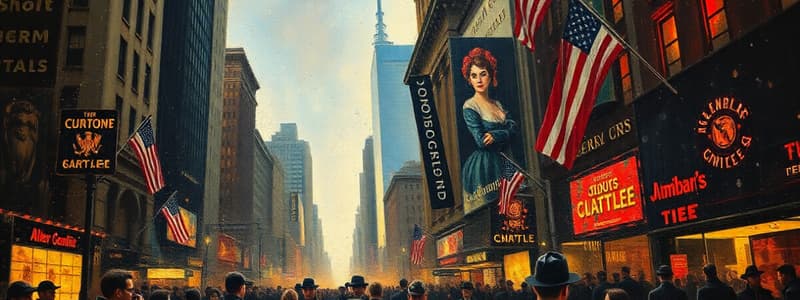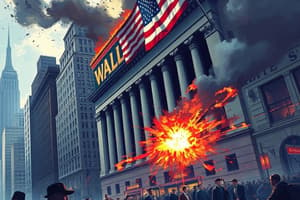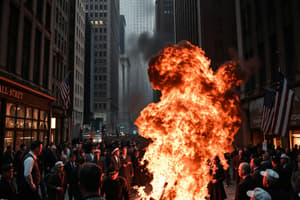Podcast
Questions and Answers
What was a significant consequence of overproduction in agriculture?
What was a significant consequence of overproduction in agriculture?
- Increased demand for imported goods
- Stabilization of crop prices
- Higher wages for factory workers
- Loss of farms for many farmers (correct)
How did the Fordney-McCumber Tariff Act affect American businesses?
How did the Fordney-McCumber Tariff Act affect American businesses?
- It boosted international trade.
- It resulted in the rise of new markets.
- It led to retaliatory tariffs from European nations. (correct)
- It provided subsidies to farmers.
What was a flaw in the Republican policies of the 1920s regarding tax cuts?
What was a flaw in the Republican policies of the 1920s regarding tax cuts?
- They increased consumer spending significantly.
- They were aimed at lowering national debt.
- They primarily benefited the wealthy. (correct)
- They were designed to improve agricultural productivity.
What percentage of Americans lived below the poverty line by the late 1920s?
What percentage of Americans lived below the poverty line by the late 1920s?
Why did overproduction lead to reduced consumer demand?
Why did overproduction lead to reduced consumer demand?
What was one result of the reckless lending by banks during the 1920s?
What was one result of the reckless lending by banks during the 1920s?
How did the concentration of wealth among the top 5% affect the economy?
How did the concentration of wealth among the top 5% affect the economy?
What was the primary cause of the Wall Street Crash, according to the content?
What was the primary cause of the Wall Street Crash, according to the content?
What economic situation did overproduction create?
What economic situation did overproduction create?
What was a significant impact of the wealth gap on consumer behavior?
What was a significant impact of the wealth gap on consumer behavior?
What was a key behavior of speculators during the 1920s that contributed to the Wall Street Crash?
What was a key behavior of speculators during the 1920s that contributed to the Wall Street Crash?
What financial situation arose due to rampant speculation by 1929?
What financial situation arose due to rampant speculation by 1929?
Which of the following describes the trend of stock prices due to speculation leading up to the Wall Street Crash?
Which of the following describes the trend of stock prices due to speculation leading up to the Wall Street Crash?
What was a notable event that predicted the crash of 1929?
What was a notable event that predicted the crash of 1929?
Which group of people most actively participated in the stock market during this time?
Which group of people most actively participated in the stock market during this time?
How did speculation specifically contribute to the destabilization of the financial system?
How did speculation specifically contribute to the destabilization of the financial system?
What economic condition did speculation fail to account for leading up to the crash?
What economic condition did speculation fail to account for leading up to the crash?
What impact did the rush to buy shares have on their prices between 1928 and 1929?
What impact did the rush to buy shares have on their prices between 1928 and 1929?
Flashcards
Overproduction
Overproduction
A situation where supply exceeds demand, leading to lower prices and decreased profits. This was a major factor in the Wall Street Crash, especially in industries like agriculture and consumer goods.
Underconsumption
Underconsumption
A situation where consumers don't spend enough money on goods and services, leading to a decline in sales and economic activity. This was a key issue in the crash as many Americans couldn't afford the goods being produced.
Fordney-McCumber Tariff Act
Fordney-McCumber Tariff Act
A 1922 law that raised tariffs (taxes on imported goods) to protect American businesses from foreign competition. This backfired by prompting European countries to impose retaliatory tariffs, restricting trade and harming American businesses.
Laissez-faire Economics
Laissez-faire Economics
Signup and view all the flashcards
Market Saturation
Market Saturation
Signup and view all the flashcards
Wealth Gap
Wealth Gap
Signup and view all the flashcards
Income Inequality
Income Inequality
Signup and view all the flashcards
Speculation
Speculation
Signup and view all the flashcards
Republican Policies
Republican Policies
Signup and view all the flashcards
Speculative Bubble
Speculative Bubble
Signup and view all the flashcards
Buying on Margin
Buying on Margin
Signup and view all the flashcards
The 'Get-Rich-Quick' Mentality
The 'Get-Rich-Quick' Mentality
Signup and view all the flashcards
Unsustainable Share Prices
Unsustainable Share Prices
Signup and view all the flashcards
Panic Selling
Panic Selling
Signup and view all the flashcards
Banking Crisis
Banking Crisis
Signup and view all the flashcards
Catalyst for Weakness
Catalyst for Weakness
Signup and view all the flashcards
Significance of Speculation
Significance of Speculation
Signup and view all the flashcards
Study Notes
Significance of Speculation in the Wall Street Crash
- Reckless Financial Behavior: Speculators in the 1920s engaged in risky practices, purchasing shares on margin (loaning 90% of the cost).
- Bubble Creation: Share prices rose far beyond their true value, fueled by the belief prices would continue to rise indefinitely.
- Confidence Collapse: When confidence waned in October 1929, speculators sold shares rapidly, driving prices down.
- Bankruptcy & Banking Crisis: Falling share prices left speculators unable to repay loans, which triggered a banking crisis.
- Destabilization of Financial System: Speculation magnified the impact of the crash, highlighting underlying economic weaknesses.
- Not Sole Cause: Speculation was a crucial catalyst, not the only reason for the economic collapse.
Other Contributing Factors
- Overproduction & Underconsumption: Agricultural and industrial overproduction, combined with lack of demand from lower income groups, weakened the economy.
- Reduced Demand: European tariffs retaliating to the Fordney-McCumber Tariff hampered export sales, compounding problems.
- Uneven Wealth Distribution: Extreme wealth inequality stifled economic growth due to a low-income consumer base.
- Republican Policies (Laissez-faire): Minimal regulation allowed reckless lending & investment practices, weakened the banking system and hampered long-term stability.
Studying That Suits You
Use AI to generate personalized quizzes and flashcards to suit your learning preferences.
Description
Explore the critical role of speculation in the Wall Street Crash of 1929. This quiz highlights reckless financial behaviors, the creation of economic bubbles, and the subsequent collapse of confidence that destabilized the financial system. Understand how speculation, alongside other factors, contributed to one of the worst economic downturns in history.




